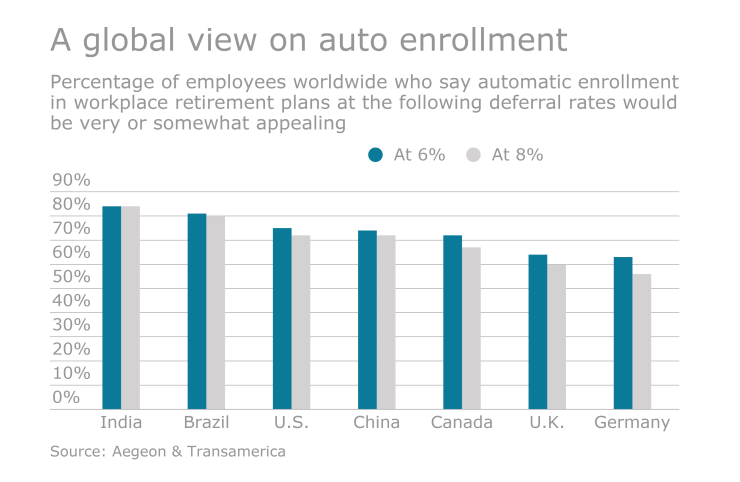Should the long-standing disparity between large and small employers when it comes to 401(k) auto-enrollment matter to advisers?
The dissimilitude is still evident in the latest survey data from the Plan Sponsor Council of America (PSCA). Specifically, the proportion of employers with at least 5,000 employees that use auto-enrollment is 70%, but less than half that (34%) for employers with fewer than 50 employees.
If plan participation rates were the same between large and smaller employers, then this would probably be a matter of small distinction. But that isn’t the case.
According to the PSCA survey of its members, the average participation rate for employers with at least 5,000 participants is 93%. In contrast, the average rate for employers with fewer than 50 employees is 78%

.
Actually, a more accurate number would probably be below 78%, according to Jack Towarnicky, PSCA’s executive director. “The people who pay a lot of attention to their 401(k)s”—i.e. PSCA members— “are more likely to participate in this survey,” he says. By implication, the more employers pay attention to their K plans, the more likely they are to auto-enroll new employees or all current employees.
Safe harbor plans
But there’s more going on than small employers simply ignoring their 401(k) plans. A common reason many don’t choose to auto-enroll is because they’re using safe harbor plan designs, which exempt them from certain discrimination tests. In other words, they don’t need to increase their odds of passing those with auto-enrollment.
Among other requirements, safe harbor plans must either make non-elective contributions of at least 3% to all employees or use one of two employee deferral matching formulas. One calls for a 100% match on the first 3% of employee deferral and 50% on the next 2% (for a total maximum of 4% of compensation). The other formula calls for a 100% match on the first 4% of compensation--another way of arriving at the same 4% maximum.
Another common explanation for the lower prevalence of auto-enrollment among small employers is cost. “You can’t look at the cost issue in a vacuum,” notes Harris Nydick, a founding partner and managing member of CFS Investment Advisory Services, LLC. “When the cost of their health plans has been going through the roof, some of these employers think auto-enrolling everybody is going to crush their budget.”
Starting small
When working with such employers, rather than push them to auto-enroll all of their employees, Nydick suggests that they limit the procedure to new hires. “That’s usually how we get them to start,” he says. But once they get accustomed to the process, those same employers often become more receptive to auto-enrolling their entire workforce.
But small budgets aren’t the only impediment to universal auto-enrollment at smaller employers, says Robert C. Lawton, president of Lawton Retirement Consultants. “In small companies, the person who’s handling benefits probably sees these employees every day, so they can bring it up with them in person,” he explains.
Since they know each other, Lawton says, the HR or benefits manager is often reluctant to risk offending these employees by taking the decision out of their hands.
When dealing with smaller employers that have reasonably healthy enrollment rates, Lawton might introduce the idea of auto-enrollment without pressing the issue—especially if he encounters resistance. But when the enrollment rate is low, he’s liable to push harder.
For instance, he currently has a prospective new client with 20% enrollment rate, and Lawton is pulling out all the stops and recommending auto-enrolling the entire workforce—and then auto-re-enrolling individual employees annually, if they opt out.
Lawton adds that he generally suggests auto-enrolling employees with a modest initial 3% deferral rate, and a 1% annual auto-increase. “With a 1% increase, hardly anybody is going to notice that additional amount coming out of their paychecks,” he reasons.





